Executive Summary
It is “accepted wisdom” that the best way to grow an advisory firm is through referrals. Of course, that means brand new financial advisors have to hustle harder to get their first few clients – because they don’t have anyone to refer them – but even for those in their early years, once there’s a critical mass of clients on board who can refer, it’s supposed to be smooth sailing from there.
Except that it isn’t anymore. In the latest Investment News 2016 benchmarking study of the Financial Performance of financial advisors, it turns out that referrals aren’t the primary driver of AUM growth for RIAs anymore. Not client referrals, nor professional referrals, nor even both combined. Instead, it’s now all about external business development and marketing strategies instead.
Notably, though, while advisory firms are driving more growth from non-referral strategies, and are indicating plans to ramp up non-referral business development even more in the coming years, there’s little consensus about what the ‘best’ marketing strategies are. From community involvement to participating on non-profit boards and hosting networking events, advisory firms are trying out a wide range of activities. In fact, the only common thread is about what seems least likely to work, which is traditional ‘advertising’ strategies (whether print, radio, or online).
Nonetheless, the shift away from referrals appears to be on, in what may be driven by the underlying challenge that there just aren’t very many “unattached” clients left to be referred in the first place. Because while independent advisors often like to talk about “taking clients away” from large firms like banks and wirehouses, the data shows that 3/4ths of new financial advisor clients are actually self-directed investors who decided for the first time to work with an advisor.
Yet with competition for self-directed investors tougher than ever, not only because there are fewer of them (as more and more have adopted advisor relationships with the growth of the AUM model in the past 15 years), but also because they’re now being solicited by everything from “digital” robo-advisors to the financial planning and wealth management divisions of Schwab, Fidelity, and Vanguard. Which means in the future, financial advisors may have to figure out how to not just bring in referrals, but do outbound marketing to persuade a client already working with an advisor to switch to them instead… a tough challenge, given the ongoing crisis of differentiation amongst most financial advisors today!
Professional And Client Referrals Vs (Other) Business Development Strategies
In the latest Investment News 2016 Financial Performance benchmarking study, a stunning new trend has emerged when it comes to growing an advisory firm: for the first time, non-referral business development is now driving materially more AUM growth than all client and professional referrals, combined.
Specifically, in its breakout of where growth is coming from across all the firms studied, the Investment News study found that the average advisory firm grew 1.8% of AUM from client referrals, another 1.2% from professional referrals, but a whopping 6.4% from other business development strategies!
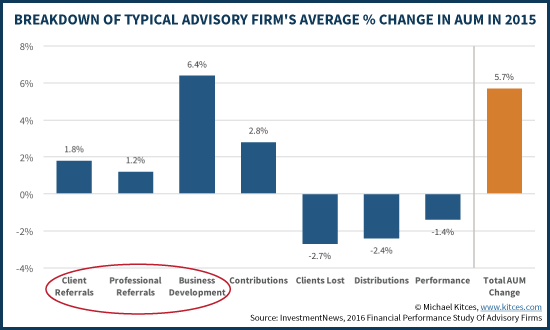
In other words, despite the accepted wisdom that the best advisory firms grow via referrals – particularly from existing clients – the data actually shows that referrals are no longer the primary driving force for growth!
And notably, the shift to growing clientele through non-referral business development is happening across all firm sizes. For “Solo” firms, this isn’t entirely surprising, as those firms tend to be newer, and may not even have enough clients to refer (nor have been in practice long enough to generate professional referrals); thus, a greater volume of business development happens by default. As the firm grows and the number of clients and established professional relationships instead, the relative mix of growth shifts, and client and professional referrals are a greater share. For the largest firms, though, non-referral business development accelerates again, becoming far more than “just” referral-based growth.
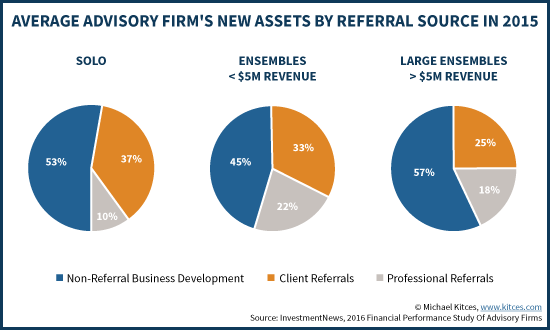
The fact that business development is materially greater than both client and professional referrals combined for large ensembles is especially notable, given the sheer volume that actually entails. Overall, the median growth from non-referral business development efforts amongst large firms was $66M of new AUM (and much more for the largest firms). And this is also notable because the largest super ensembles are still only spending the roughly-2%-of-revenues on marketing as other smaller advisory firms. However, given their size, the median 1.7% marketing spend by super ensembles equates to over $400,000/year on marketing, and that size of a marketing spend appears to be scaling very effectively (allowing the largest firms to produce a greater business development growth result for a comparable percentage-of-revenue marketing spend).
Business Development And Marketing Methods that Work (Or Not)
While a growing number of advisory firms appear to be focusing more on non-referral business development, the Investment News study also reveals that there is no clear consensus yet on what the best type of non-referral marketing strategy actually is.
For instance, the most popular strategies for business development appear to be driven by individual advisors of the firm, through activities like community involvement and volunteering on non-profit boards, along with more firm-wide efforts like sponsoring community events or hosting networking meetings. And in a nod to our emerging digital environment, many advisory firms have also been adopting social media, email campaigns, and trying to actively capture leads on the firm’s website. However, there does at least appear to be some consensus about the least successful strategies for the typical advisor: the ones that require the most direct spending for a return on investment, including paid search engine ads, direct mail, and radio or print advertising (though a number of firms reported solid success with radio/television shows, and to a lesser extent newspaper/magazine columns as well).
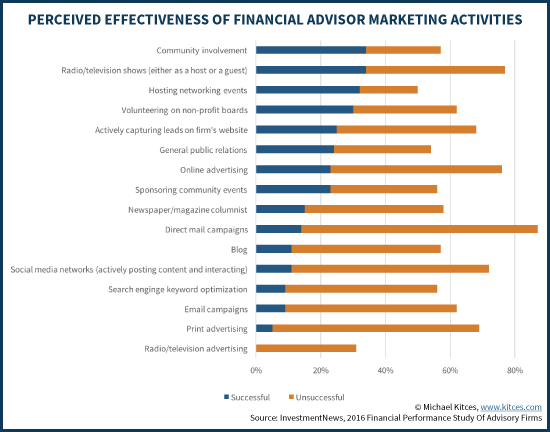
Still, though, the chart above reveals that the most successful marketing strategy appears to be the most creative – with the highest rated strategy being the nebulous “other marketing activities”, which was only implemented by 10% of firms, but dominated the most successful reported outcomes. (Unfortunately, nothing in the Investment News study reveals what these “other” marketing efforts actually were!)
Amongst the largest advisory firms, the most “winning” strategies are even less clear. Instead, it appears that almost any/every strategy is having at least “some” success, with no strategy in a clear standout position. In part, that may simply be because large firms are so large that it takes multiple business development strategies to succeed. Or it may simply be a recognition that almost any strategy can succeed, as long as the firm is large enough to put sufficient resources behind it (and large firms do tend to have the resources!).
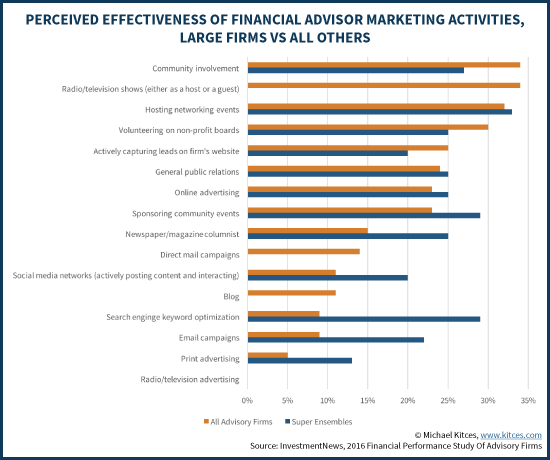
Nonetheless, while the particular marketing strategies vary, the Investment News study overall found that there is a substantial uptick in firms’ focus on developing new (non-referral) marketing strategies going forward.
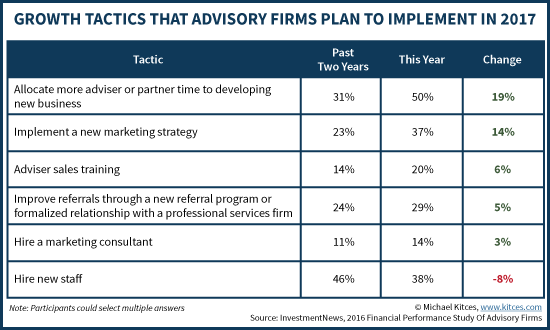
This dramatic shift in planned growth initiatives implies that not only are referrals no longer the leading strategy for growth, but that they’re about to fall even further behind, implying perhaps that the “well” of referrals is starting to run dry for many advisory firms.
In part, this may simply be the challenge that any established firm faces as it grows an increasing number of long-term established clients. After all, the reality is that most clients who will refer do so in the first few years, when they’re most enthusiastic about their new advisor relationship, and still have a personal network that has not yet been tapped. After several years, though, eventually the most happy and engaged clients who are likely to refer will have referred everyone in their network who can be referred… and at that point, the referrals from that group of clients will likely slow down.
Except for a large firm that’s been in practice for decades, that actually means the majority of clients have already given all the referrals they’re likely to! After all, for a new firm in its first 5 years, every client is still in their first 5 years. So ‘everyone’ is still a potential referrer. But by the 20-year mark for established firms, though, the reality is that 80% to 90% of the clients are now “long-term” clients. And even if the firm can still get a healthy referral rate from clients who haven’t yet tapped their referral networks, it’s simply not possible to sustain growth on 100% of the practice when only the 10% - 20% of clients who joined recently are driving the referrals.
Is There A Shortage Of Potential Clients For Future Growth?
While it’s possible that the slowdown in referral activity amongst larger advisory firms is nothing more than a struggle in maintaining referral-based growth rates from an ever-larger number of long-term (and likely tapped out) clients, the question also arises as to whether advisors are simply reaching the point that there aren’t enough new clients to get in the first place. Especially since the Investment News data doesn’t show any level of advisory firms, large or small, getting especially good growth rates from client and professional referrals at this point. And similar to the recent FA Insight study, overall advisory firm growth appears to be slowing across the board.
The question of how many potential new clients are even available to be referred matters because, despite the popular notion in the independent advisor community that their clients are typically coming from large firms (e.g., wirehouses), the Investment News study finds that in reality 74% of new clients for advisory firms come from self-directed investors who decide to finally start working with an advisor. Only 16% of new clients for advisory firms are actually coming from a bank or wirehouse, and only 10% are taken away from a competing RIA or an advisor at an independent broker-dealer.
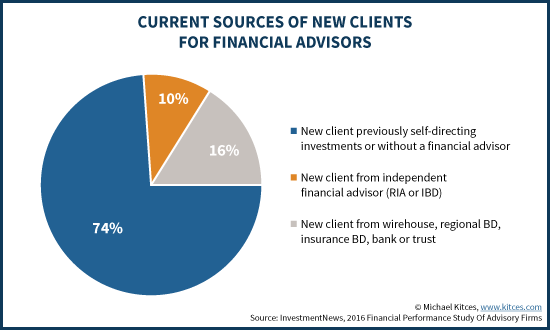
What this means is that at least up until now, the fight for clients has actually largely been a fight for self-directed investors who decide that they no longer want to be Do-It-Yourself (DIY) investors and instead are ready to delegate to an advisor. Or perhaps are one of the few who have had a new/sudden wealth event, creating more money for themselves than what they want to manage themselves.
Yet given the slowing organic growth rates in advisory firms for the past several years – now made more evident with last year’s flat market – it’s not entirely clear how many “unattached” self-directed investors are really left out there. And of the ones who are available, how many of them even both to ask friends and family for a referral, instead of just going online to search for an advisor directly.
In addition, the potential shortage of available unattached clients is only further exacerbated by the fact that such investors who go online to find an advisor are already the ones most likely to be targeted by low-cost online discount brokerage firms, and also are the ones being targeted most heavily by the online digital (i.e., robo) solutions.
Furthermore, a growing number of online and traditionally-self-directed firms are going after “DIY” investors even more directly. From the growth of Schwab Private Client, to Fidelity’s Private Client Group, and the new behemoth Vanguard Personal Advisor Services, self-directed investors are not only being heavily solicited by independent financial advisors, but also by the very platforms on which they’re already engaged while still self-directed!
In other words, not only may the number of available self-directed investors be dwindling, but independent advisory firms have more competition than ever in the space, including from some of the biggest brands that currently support them (e.g., Schwab, Fidelity, and Vanguard). And while there’s always the potential for ‘new wealth’ clients, the sluggish growth of the economy means those new potential clients are only being created “so fast” in the first place.
The Future Of Business Development For Financial Advisors
Ultimately, what all of this suggests is that in the future, advisory firms may increasingly have to survive by competing more directly against other advisory firms to pull clients away from them – a world that is not conducive to traditional ‘referrals’, given that clients tend to be ‘sticky’ and have a lot of inertia and aren’t likely to ask for a referral when they’re already reasonably comfortable with a current advisor.
In fact, the data from the Investment News study suggests that this may already be happening, given slowing growth rates, lackluster growth from referrals, and the ongoing recognition of a “crisis of differentiation” for the typical advisor. Which doesn’t bode well for most advisory firms in the future; in a world where so many struggle just to explain why a prospective client should go with them over another (independent) advisory firm, the odds of peeling clients away from another advisory firm look bleak. Especially for small independent firms, where even being a fiduciary isn’t much of a differentiator anymore in a post-DoL fiduciary world.
Nonetheless, firms that want to grow in the future will have little choice but to figure out how to navigate a landscape where (passive) referrals aren’t the optimal (or even an effective) strategy anymore.
So how will advisory firms compete for new client business in the future?
Realistically, large firms will try to compete on the strength of their regional or even national brand. In fact, the Investment News study already found that the largest advisory firms were slightly more likely to be growing by taking away clients from other independent firms. This trend will likely only continue, especially in a world where consumers can’t really evaluate the quality of one advisory firm to another up front (you don’t “know” until you’ve experienced it), and therefore must rely on external perceived factors like the firm’s brand and recognition in the community.
In turn, smaller advisory firms will increasingly be forced towards having a niche or specialization to attract clients away from better-known competitors. Because the reality is that if you’re a divorce specialist, you can get a client away from their existing advisor, if that client is going through a divorce and feels they need more help. Or if you specialize in doctors selling their medical practice, you can get that doctor away from another advisor when they actually need help to do the big transaction. In other words, niches that fit around high-stakes financial problems may be able to pull away clients, because the clients have a substantial need, and the solutions are specialized enough that the client may not be confident their current advisor has all the answers.
Ironically, in this context, referrals could even make a resurgence as a growth model of the future, because specialization and known expertise actually is conducive to inbound referrals. But the only advisors who would garner referrals in that future are the ones who get referred based on their niche or specialization, not merely because their client referred a friend or family member (who, in all likelihood, will already have an advisor of his/her own by then!).
The bottom line, though, is simply to recognize that the industry benchmarking data is now showing that despite the conventional wisdom of the effectiveness of referrals, that relying on referrals – typically from unattached do-it-yourself clients who are looking for their (first) advisor – may no longer be sustainable as a growth strategy (unless perhaps refined as a focused niche referral strategy). And to the extent that many advisors still report that the majority of their growth is from referrals, that may not be an indicator it’s actually a ‘best practice’, but merely the result that inevitably occurs for advisors who engage in no other business development strategies… as evidenced by the fact that client referrals alone are now producing less than 2% organic growth rates for the typical advisory firm!
So what do you think? Are referrals dying as a source of new business? Is there a shortage of potential for new growth? How will firms generate referrals when an increasing number of advisors are independent and look the same to a prospective client? Please share your thoughts in the comments below!





So advisors were asked about the perceived effectiveness of marketing activities, not ACTUAL effectiveness? GIGO.
Not all marketing metrics are directly measurable.
If you only measured direct ROI results, virtually no companies would brand.
– Michael
Agreed, not all results from marketing efforts can be directly measured.
Yet the study solicits *perceived* effectiveness of marketing activities in which, I assume, respondents don’t all participate or engage whatsoever!
I can’t infer that referrals are dead from a survey that, in my opinion, fails to accurately represent marketing efficacy in the first place.
Bill,
I believe the point of the survey was self-assessed perceived effectiveness OF MARKETING STRATEGIES YOU USE.
I.e.:
– Which of the following do you DO
– How effective do you think those ARE
This wasn’t a speculative survey of “rate the effectiveness of 17 strategies you’ve never done and have no experience with.”
– Michael
Thank you for the clarification. I did not read in the post body or in the charts that specific efficacy responses were limited to those respondents who self-identified as actually engaging in the activity. This does reduce the potential for garbage-in data.
Draw what conclusions you will –or simply dismiss– the referrals data (Michael very faithfully lays out the finer points), but in terms of survey design around marketing effectiveness, the study first prompts respondents to identify the activities they engage in, and then asks them to rate the perceived effectiveness of just those activities their firm utilizes.
I appreciate the info! One of the biggest pieces of advice I received early on was an established advisor continually asking me “what kinds of marketing are you doing?” This really showed me the necessity of getting out and building that brand rather than sitting back, asking for and waiting on referrals. With new tools like social media there are so many great ways to reach potential clients. It really empowers the new advisor to see that there are things they can do NOW.
Do you know if the radio/TV included podcasts? Being a guest, having your own or sponsoring one? I’m thinking this is the newest way to reach a niche audience…
So how do I know this survey was not designed by the same firms who are trying pretty creative ways to sell their lead generation services. They have gotten pretty aggressive lately. May be the financial advisor community is attracting more and more folks who are simply not referable. CFP Board sometimes makes the assumption that just past our courses, pass the exam and boom, you a professional. There is no testing or barrier on being referable to enter this business. There are more and more ways to reach out using the social media using a niche. This was harder to do on direct mail marketing. So it is not surprising more advisors are looking at other sources, lets be honest getting referals is hard business. Spending money on social media is easy. There is also a nice side to technology, if I were working in the 50’s, I would have to ask for referals or have them given to me. Now I can see who my clients hang out on facebook, who is recommending them on LinkedIn, what are they reading on their blog, who they voted. In many ways, once you get a happy client, it is much easier to get the conversation to generate more referals.
To make this survey more scientific, we would also need to test if clients are becoming less and less trusty and this is causing firms to depend more on non -referal strategies.
Questioning sources is always valid, but this survey was produced by the Ensemble Practice, whose principal came out of the Moss Adams division’s benchmarking services unit in the past.
They’re arguably THE most reputable independent benchmarking survey company working with independent advisors today. So this definitely isn’t a matter of a survey company with an ulterior motive.
That being said, you’re right that we could ultimately attribute the CAUSE of declining referral efficacy to a lot of other reasons (including the potential that it’s a matter of damaged consumer trust), and that aspect of the question in particular deserves more study.
– Michael
In my opinion, this study seems to suggest that financial advisors are not as effective as they could be with getting client referrals and/or referrals from professional sources. All of the financial advisors I work with agree that they are not effective with asking for referrals and many are not comfortable with the process at all … so they don’t do it. They sit back and wait for the passive referral.
In addition, several of the non-referral marketing strategies mentioned can and should be considered as a component to an overall comprehensive referral marketing plan. Strategies such as networking, serving on boards, becoming involved in your community for example all will generate referrals as relationships are developed and solidified over time. A comprehensive referral marketing plan is much more extensive than simply referrals from clients and other professionals. Referrals are a direct result of developing relationships. Any marketing strategy that leverages the personal relationship to gain new business qualifies as a referral strategy. If the non-referral marketing strategies mentioned above were combined with the client and professional referrals, the outlook would be quite different.
It’s no surprise that giant firms who put boat loads of funds towards increasing their exposure and brand identity see results from marketing efforts that require no relationship. Comparing their success rate with those firms who do not have unlimited funds for such marketing efforts is irrelevant.
Michelle,
I’d certainly agree that many/most advisors could be better at trying to obtain referrals. Yet the point remains that in the past, what they were doing (bad though it may have often been) was enough to drive growth, and now it’s not working so well. Which still marks a significant shift in the landscape.
Similarly, the “large” comparison firms here aren’t “firms with unlimited funds”. They’re simply independent firms (often likely built with referrals themselves in the past) that are somewhat larger than their peers and are finding greater efficacy with other paths of business development (and in the aggregate, are out-growing all the referral-based firms combined).
Comparing their success rates are HIGHLY relevant, as for those who DO own the smaller independent advisory firms, it raises real and serious questions about whether the firm needs to manage its growth differently, strategize around a different marketing approach, or in the extreme even seek to “tuck in” their firm underneath one of the larger ones (which in point of fact is ALREADY an emerging trend)…
– Michael
It’s true that some smaller independent advisory firms are tucking into larger firms, however there are many things driving that trend. These larger independent firms that have been built on referrals are now fiscally able to invest in more costly marketing strategies, whereas in their developmental years, they may not have been able to before. Consequently, they will see a return on that investment in part due to their name recognition. Smaller firms still need to leverage their social capital in a manner that is strategic, proactive and comprehensive. For I believe you once said, “Expecting that good growth by referrals will happen without the efforts involved in implementing a proactive referral marketing strategy is just a setup for failure.”
I noticed that there does not appear to be a category for seminar marketing, which I know in the past many advisors have done to market their practice. Is that particular marketing strategy all but dried up or do you think it is still effective? I have mixed feelings about it so I was just curious about your view.
Mark,
I don’t think seminar marketing is ‘dead’, although it is arguably pretty tapped out in some dense population areas that have been saturated with seminar solicitations for years.
I do still see some advisors finding success with seminar marketing, but they’re all doing a well-refined process they’ve fine tuned for years, from the seminar itself to the advertising to get people in the door, the ask at the end, and the follow-up afterwards. To me, what that suggests is that systematized seminar marketing may still be reasonably viable, but ad hoc seminar marketing probably isn’t going to cut it anymore…
– Michael
As usual, this is an excellent, insightful and thoughtful article. Though the Investment News survey is only
one study, the report is very interesting and helpful as it outlines what’s working and what’s not working. Your point that there is a “potential shortage of available unattached clients” is key. Assuming that is true, and I believe it is, it’s true for all sources of new clients and all marketing activities including but not limited to referrals. Clearly “producing less than 2% organic growth rates for the typical advisory firm” is inadequate for growing the business and considering normal losses of clients whether related to perceived
poor service or performance, death, client relocation, etc. I think it’s also important to note that 2017 “growth tactic” projections will as usual not likely match actual implementations. As Peter Drucker said, “Plans are only good intentions unless they immediately degenerate into hard work.” As it often happens, change plans, like New Year resolutions, rarely become reality without some major dramatic event. As is said, “Change happens when the pain of staying the same is greater than the pain of change.”
I agree with the conclusion that there is no best type of non-referral marketing strategy to date and that almost any/every strategy is having at least “some” success, with no strategy in a clear standout position. However, I still believe that referrals from both clients and professional sources are the most cost effective and efficient method for getting introductions even though the “well” in some cases is getting dryer. I do not believe everyone who can be referred has been referred. In fact, it could well be a business death knell to believe that. I think your points are true that:
— That clients tend to be ‘sticky’ and have a lot of inertia
— Specialization and known expertise actually is conducive to inbound referrals
Given no matter what marketing activities an FA decides to implement, it is true and has been for years that potential new quality clients are limited. So, yes, it’s hard to get referrals or better yet, introductions. The biggest issue you mention however is FAs “aren’t likely to ask for a referral” at least in a high percentage of cases. And, if they are, I believe there are several approaches that are not likely being
effectively applied in seeking introductions which are in part based on a somewhat unique way of approaching an FA’s service deliverables. In summary, I believe the potential for introductions, nee referrals, still exists though I do agree that one or two additional approaches will be of value to implement
and test. Thank you again for a very thoughtful piece.
Michael – all good points. What struck me most in the survey was the 74% of new clients came from previous DIYers. Instead of focusing on referrals or what advisors are doing, I chose look at the consumer perspective. To me, there is such a “sea of sameness” out there that many clients are not leaving their current advisor/planner/broker because they don’t see a real difference. In fact, a recent survey from CEB said that 88% of the 171 firm’s surveyed said that their firm’s value proposition centered on holistic planning. If 88% of the firms SAY they are doing the same thing, why would a client leave their existing relationship just to get more of the same? No wonder new clients are coming from the DIY – they have no benchmark or previous experience to judge what the firm says or does.
I think referrals will dry up if advisors can’t create a better, differentiated experience – one that truly engages the client. One that fouces on a niche for example. But they don’t have to tap out after say 5 years. At the firm level, if it is growing new clients each year, those new clients have additional networks for the advisor to tap into. Additionally, as the client relationship matures, the services and experiences can evolve and keep the clients engaged and top of mind for referrals to others in similar (sometimes new) situations.
John,
Indeed, this ’emerging’ struggle in a sea of sameness has been underway for quite a while now. I dubbed it a “Crisis of Differentiation” back in 2013 (see https://www.kitces.com/blog/are-financial-planners-experiencing-a-crisis-of-differentiation/) and although that article got little traction or attention at the time, I think we’re now really starting to see the impact and consequences… :/
– Michael
I think you’re right on Michael. Savvy Advisors are out there making things happen vs. waiting for business to come to them. When I work Advisors I teach them to use public speaking as a way to bring in clients and create brand awareness.
In small group, work shops, seminars or what other mediums and what seems to be best?
John-I recommend my advisors put on their own events (some call it a workshop others a seminar) and that they get booked to speak at other people’s events.
Let’s look at seminars first. If you’re going to put on your own events it’s crucial that you know how to create an effective presentation. An effective presentation is one that is engaging (people are not bored and actually enjoy listening to it), gives value, and gets the right audience members lining up after the talk to set an appointment to meet with the Advisor. The problem I see right now in the industry with seminars is that advisors are shelling out a lot of money to put events on (usually $1000’s) but they have never learned how to be an effective speaker nor have they learned the science behind creating talks that convert so the ROI is minimal or non-existent. I spoke with an advisor a few weeks ago who shells out $6000 a quarter for event expenses but doesn’t know how to convert. This is madness! All this to say if you’re going to put on events know your ideal target audience, make sure you have a compelling topic, and make sure you know how to create a talk that converts.
On the flip side, most advisors have never considered the fact that they could actually get booked to speak at someone else’s event. That is one of the first thing I teach my clients how to do. Why? Because not only is it free-no cash outlay by you and some of my clients actually get paid to speak- but you leverage the name of the organization who invited you and with that you get instant visibility and credibility all of which increase your brand awareness. Advisors who get booked at someone else’s events have unique and niched topics. They are not pitching Retirement 101. For example one of my clients has a presentation for women going through divorce, another client focuses on college planning, and another on saving taxes for business owners. If you go this route pick a specific niche and put a unique spin on the topic. This will increase your chances of getting booked to speak at an event. And of course like seminars be sure you know how to create a presentation or how to customize a compliance approved talk so it’s what I call “Crazy Good”-engaging, gives value, and coverts.
My advice- Do Both. Put on your own events and get booked at other people’s events. The more you’re out there the more known you will become, the more clients you will get, the more people you can help!
Thanks for sharing your perspective, Deirdre! 🙂
– Michael
You’re welcome Michael and thank YOU for providing a great space to learn and share ideas.
DIY investors represent 74% of new clients? Something is odd about that. Are they paying fees for service? Or are they receiving pro-bono work in the hopes that one day they will be fee paying?
Referrals will only fail if the financial planners fail to do their job properly. The best way to do this is for the client to “own and understand the risk level in their portfolio” It is all about proper client education. A very simple starting point is to ask the client “How much could your portfolio fall overnight without you losing sleep, and selling after the fall?” If their answer was 25%, then limit their equity exposure to 50%. This is because we know from history that equity markets fall be about 50% every 10 years. Then after the next crash, you will keep the client and get plenty of very good referrals. Having said that, you do need a multi-faceted marketing strategy. Mine is my website at http://www.worcester.com.au, and my blogs. I have over 1,000 followers of LinkedIn, FaceBook and Twitter. When I add a new blog, I only need to send out 3 email to let all my followers know there is something new to read.
Great post Michael :).
Quick question: Do you know of any services which are helping financial advisors with personal branding and building digital lead gen funnels?
This may be a “duh” moment, but as I was reading this article and your other post on the challenge of “differentiation for financial advisors”, my first thought was “Wow – Personal Branding is going to become even more important for financial advisors in the very near future”.
I’d posit 2 factors which are driving this:
1) The next generation is hip to mobile / virtual advisory.
2) Once you make the leap to digital service delivery, differentiation becomes even more critical -> when you’re competing with the world, you need to approach only your perfect market
I think this is great news for those that can make the shift – it allows for deeper specialization and the profitability that comes with it.
I think genyplanning.com is a great example of this shift – I first heard of them on the TMBA Podcast a while back.
In essence, it seems like the independent financial planning industry is going the path that bloggers, coaches and infopreneurs have been treading for a long time now (the path you yourself are on with this excellent site ;)) – content / social media + personality + automated marketing funnels to generate ideal leads online.
Thanks again Michael 🙂
Hi Michael!
My Financial Advisor coaching clients are schooled on how to ask effectively for referrals. I suspect many don’t know how to do so — “Who do you know?” doesn’t work well. I also coach them on their networking with other professionals to get introductions to prospects — most FA’s think going to Chamber events once a month and handing out their business card is networking. And you might be surprised with how many FA’s think they’re good at sales until they start the coaching process. If they don’t learn these skills, “other marketing activities” doesn’t sound like the path to success.
PS — Forgive my tardiness, just saw the article this morning.
Thanks great post – definitely clear that the evolution of the advisor model is accelerating. The robos are demonstrating that you can engage and win clients in a scale-able way by starting with digital tools and then introducing a hybrid digital / human solution. This is inline with your other article on the future of planning https://www.kitces.com/blog/differentiating-next-generation-financial-planning-software-advisor-fintech-differentiation-focus/
I would be very interested in seeing an updated study done on this subject again.